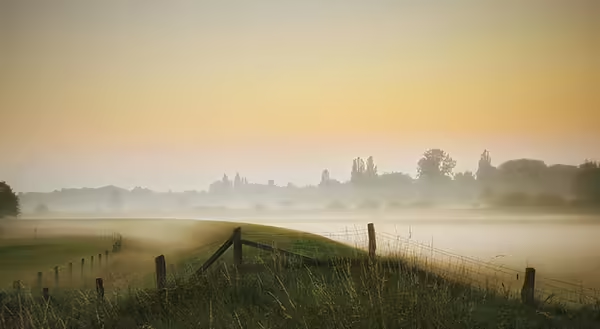
We are bound to have fog from time to time. I still remember when I was in my late teens and insisted on going to see some friends when I could barely see the edge of the road. My parents were not happy. Some areas, such as San Francisco or London, have fog more often. The cause of fog can depend on location.
Radiation fog
The most common cause of fog in Illinois is when there is a lot of moisture in the air on a clear, calm night. This creates what is known as radiation fog. When you hear the word radiation, I hope your thoughts don’t only go to atomic bombs or superheroes. Radiation means giving off energy, which everyone and everything does.
On a clear night, the earth’s surface gives off energy which quickly escapes to space. The quicker energy is given off, the cooler the surface becomes, which in turn cools the air above it. If the air cools to the point where water vapor can condense into liquid droplets, fog forms. The fog may be a few feet or over 100 feet thick. Then it disappears by 9 or 10 a.m. Why?
Here comes the sun
When the sun comes up the next morning, some of the sunlight can penetrate through the fog and is absorbed by the earth’s surface. As the surface warms, it starts warming the air above it, making the liquid water evaporate back to water vapor.
The sun doesn’t burn the fog away; if that were the case the fog would disappear from the top down. The fog does not physically lift either. It appears that way because it takes time for the air higher up to be warmed enough for evaporation to occur.
Advection fog
Advection fog is what occurs in San Francisco. Advection means moving horizontally. The fog forms when moisture-laden air in the Pacific moves over a narrow band of cold water next to the coast, which cools the moving air to the condensation point. The fog then moves onto the coast. This type of fog is common along western coastlines. A lot of these areas also don’t receive much precipitation, so the fog is the only moisture these spots get. Illinois occasionally will have an advection fog when warm moist air moves over a very cold surface such as snow.
Case in point, the time I was driving and could barely see the edge of the road was in February with snow on the ground. I don’t think at the time my parents appreciated my explanation of why the fog was there.
Upslope fog
Upslope fogs happen when humid air is forced to higher elevations. As the humid air cools and moves higher, condensation can start. We don’t worry about upslope fogs here in Pancake Flatville, Illinois.
Evaporation fog
I find this next type of fog very cool. It is evaporation fog. Imagine it is early November after a relatively warm October – which isn’t hard to imagine anymore. A very cold batch of air comes in, and you get up in the morning and see wisps or patches of fog over the local lake or pond. The warmer water is evaporating into the cold air, but the air is so cold that the evaporated water immediately condenses back into water droplets. Grab your camera as evaporation fog makes for a great photo!
Frontal fog
When warm humid air associated with a warm front moves up and over cooler drier air, precipitation falling through the cooler air will evaporate. If this happens enough, the cool air cannot hold any more water vapor, and condensation starts. These don’t occur all that often, but if we do get them, it will typically be in late winter.
Do you have a question on a weather or climate topic? Send it my way at friend@illinois.edu. It might become my next post!
ABOUT THE BLOG: All About Weather explores the environment, climate, and weather topics for Illinois. Get in-depth information about things your weather app doesn't cover from summer droughts to shifting weather patterns. Never miss a new post! Sign up for our email list.
MEET THE AUTHOR: Duane Friend is the Illinois Master Naturalist Coordinator and Climate Specialist with University of Illinois Extension, serving the organization in many roles since 1993. Duane provides information and educational programs to adult and youth audiences in the areas of soil quality, weather and climate, energy conservation, and disaster preparedness. These programs provide practical solutions for families, farms, and communities. He assists families in creating a household emergency plan, farmers with the implementation of soil management and conservation practices, and local government officials and business owners with energy conservation techniques.